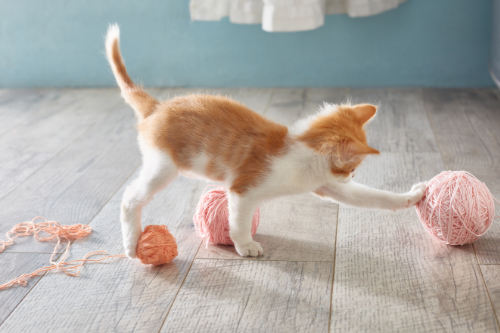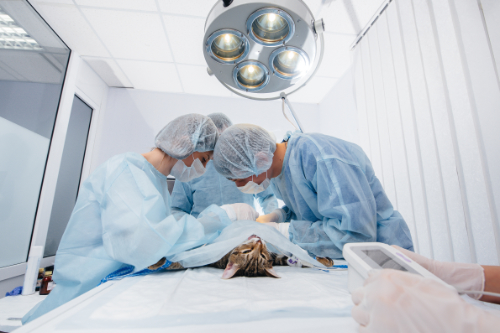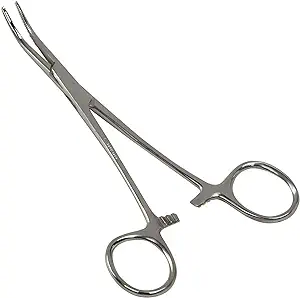Introduction
Cats are curious creatures and have a tendency to play with different objects or even grab them in their mouths. Sometimes, however, your cat may accidentally swallow something that gets stuck in its throat. As an owner you can of course be very worried about this. In this article, we’ll discuss the possible causes, symptoms, and treatment if your cat has something stuck in its throat. That way you can respond adequately in case of an emergency.
Causes: objects that can get stuck in your cat's throat
There are various objects that we as a veterinarian regularly have to remove from a cat’s throat. The most common one is a piece of grass. After all, cats like to eat grass to regurgitate their hairballs. Every once in a while, it happens that the piece of grass does not take the right route and gets stuck in the nose / throat transition. But we can also find other plant particles there. There is no choking hazard with these items, but they can be quite a annoying for your cat.
We also often see buttons, needles or parts of (their) toys. In addition, they can also swallow threads where part of the thread remains hanging on a tooth and the rest is swallowed. You’ll be amazed at how often this happens! The intestines will then “creep up” over the wire and will therefore not be able to perform their function. Resulting in death. Incidentally, the thread in their throat itself often does not bother them that much.

Symptoms in a cat that has something stuck in its throat.
- Gagging or throwing up without anything coming out of their throat
- Drooling. The saliva cannot leave the mouth through the normal route if the cat cannot swallow properly
- Difficulty swallowing or refusing to eat.
- Changes in voice, such as wheezing or hoarseness.
- Severe breathing problems, such as rapid breathing or chest tightness. In extreme cases, he may not be able to breathe at all.
- Purulent discharge from the nose. Especially blades of grass can be in the throat for a longer period of time and then cause an infection. The body reacts with the formation of pus to clean up the blade of gras.
Treatment if something is stuck in your cat's throat
Do you suspect your cat has an object stuck in its throat? Then it is important to take immediate action. If the object is there for a long time, it can make breathing difficult. But it is also possible that the object damages the throat, esophagus or trachea because it blocks the blood circulation of the mucous membrane. The mucous membrane cell (or even the deeper layers) will then die. This damage will repair with scar tissue. And that tissue is usually stiffer and thicker than the normal tissue, so that the throat, esophagus or trachea can no longer function normally. The less the damage, the greater the chance of a full recovery.
Take the esophagus, for example. It should be able to stretch a little when food comes through. If that is no longer possible due to the scar tissue, the food will get stuck in the esophagus and will not reach the stomach. So digestion can not take place. Your cat will starve if left unresolved.
If you think there is something in your cat’s throat, it is therefore necessary to investigate whether it is really there and then to remove it (or have it removed) as soon as possible.
Keep calm
It is essential to behave calmly and reassure your cat. Cats can pick up on your anxiety or panic, which can stress them out. And a stressed cat will not be examined in his throat, let alone treated.
Check your cat's breathing
Assess your cat’s breathing. If you notice that he has severe breathing problems or can’t even breathe at all, you should see your vet immediately. Do check your cat’s throat first (if he allows it in his own panic) to see if you can easily remove the object yourself. But try this for 10 seconds at the most! Then you need to go to your vet with great urgency. If it’s something big you can often push it back up the throat from the outside towards its nose and then remove it from the mouth with a pair of pliers like below.
Examine your cat
If he’s not short of breath, you’ve got a little more time. You can carefully inspect his throat for any visible foreign object. Be careful, though, as your cat may react fearfully or painfully. Can’t you get it out easily with a pair of pliers? Then go to your vet. He or she can give your cat a short-term daze to remove the object. That is a lot less stressful for your cat and the chance of damage to his throat is much smaller because the muscles in your cat’s mouth and throat relax due to the anaesthesia.
Contact your veterinarian
Call your vet as soon as possible and describe the situation. They will guide you on the right steps to take and will almost always ask you to come straight to the clinic unless they believe he will suffocate in the meantime. Your vet will be able to take the following steps:
- Sedation: If the object is within reach and your cat is calm enough, the vet may be able to medicate your cat to remove the object. If your cat is very panicked, a short-term general anesthetic may be necessary.
- Endoscopy: In some cases, the vet may use a small camera on a flexible tube to locate and remove the foreign object. This is often done with blades of grass, for example. The camera can then also be used to look into the nasal cavity to see if serious damage has been caused by the blade of grass (or whatever was in there). Or that there is a second piece, for example.
- Surgical procedure: If the object has become lodged deeper in the throat or esophagus, surgery may be necessary to remove it safely. This is done under general anesthesia. However, this is very rarely necessary

Aftercare
After treatment, the vet will provide instructions for your cat’s aftercare. It may be necessary to give him medication such as antibiotics or painkillers, adjust his diet (wet food instead of kibble) or limit the amount of exercise he may have during the recovery process. It all depends on the amount of damage incurred. If your cat refuses to eat you should call your vet for help! Follow your vet’s instructions carefully and schedule a follow-up appointment if necessary.
Good luck for your cat and you!

